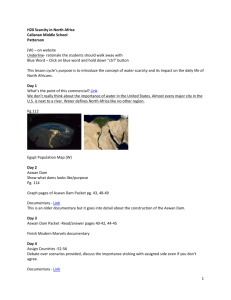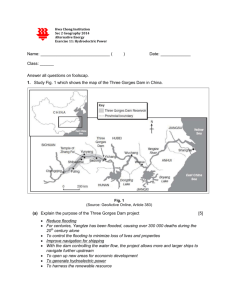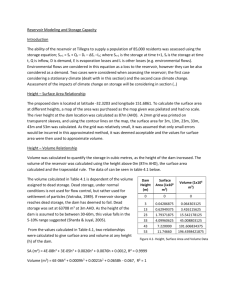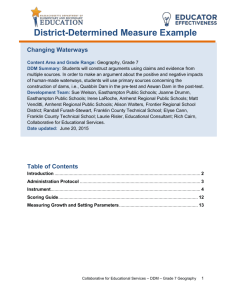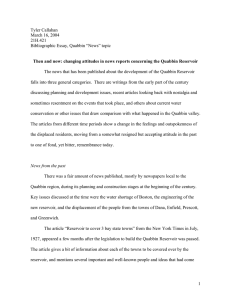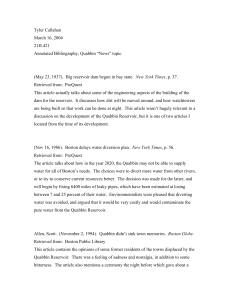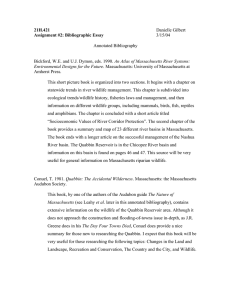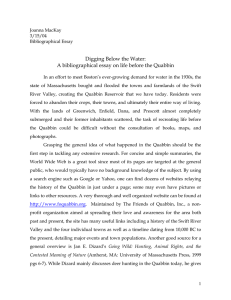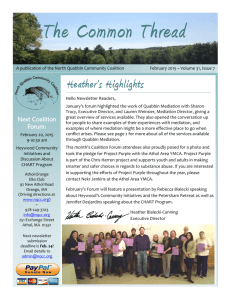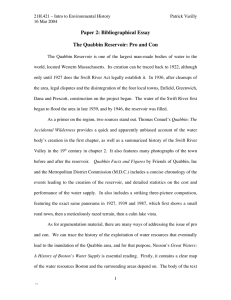Changing Waterways - Massachusetts Department of Education
advertisement
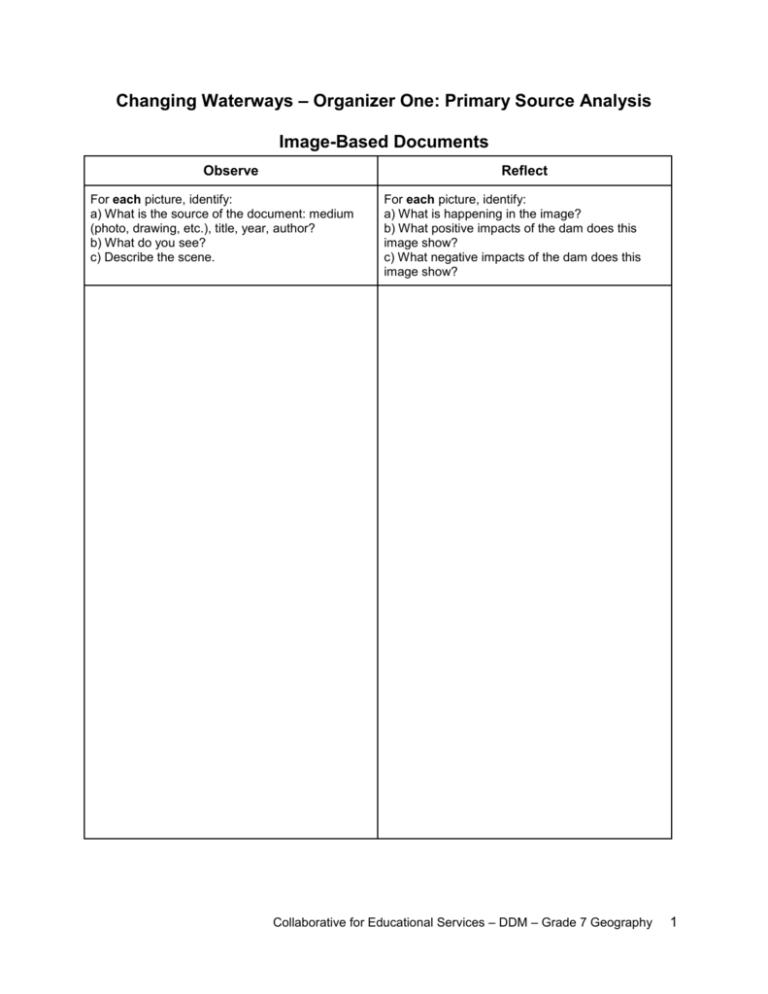
Changing Waterways – Organizer One: Primary Source Analysis Image-Based Documents Observe Reflect For each picture, identify: a) What is the source of the document: medium (photo, drawing, etc.), title, year, author? b) What do you see? c) Describe the scene. For each picture, identify: a) What is happening in the image? b) What positive impacts of the dam does this image show? c) What negative impacts of the dam does this image show? Collaborative for Educational Services – DDM – Grade 7 Geography 1 Changing Waterways – Organizer One: Primary Source Analysis Maps, Charts, & Text-Based Documents Observe Reflect For each map, chart, or text-based document, identify: a) What is the source of the document? What is it: (letter, report, article, etc.)? What is the title, year, author? b) From each document, list four facts about the impacts of the dam. For each fact that you listed: a) Identify which of the facts you listed show mostly positive impacts and which ones show mostly negative impacts. Collaborative for Educational Services – DDM – Grade 7 Geography 2 Changing Waterways – Organizer Two: Organizing Evidence 1. Using evidence from the sources provided, complete the graphic organizer to show the positive and negative impacts of this dam. Primary Source (List) Evidence of Positive Impacts Explanation (Why do you say that it is positive?) Primary Source (List) Evidence of Negative Impacts Explanation (Why do you say that it is negative?) Collaborative for Educational Services – DDM – Grade 7 Geography 3 Changing Waterways: Brief Essay Questions 2) Which is most convincing (positive or negative)? Explain the reasons for your opinion. 3) Conclude: Do the benefits of this dam outweigh its costs? Write a paragraph answering the question using evidence from the sources and any prior knowledge you may have. Collaborative for Educational Services – DDM – Grade 7 Geography 4 Primary Sources Quabbin Dam and Reservoir Documents A, B, C, E & F available from CES: http://EmergingAmerica.org/Downloads. ● ● ● ● ● ● ● Document A: Current Quabbin Reservoir Reservation Watershed Map ○ Source: Commonwealth of Massachusetts, Department of Conservation and Recreation, Division of Water Supply Protection, Office of Watershed Management. 2015. ○ Explanation: This map shows the current boundaries of the Quabbin Reservoir with an overlay of the original town boundaries. Document B: Map of Proposed Swift River Reservoir 1922 ○ Source: Friends of the Quabbin. ○ Explanation: The original map from 1922, republished by the Friends of the Quabbin, shows the towns that were then proposed to be flooded. Four towns flooded: Enfield, Prescott, Greenwich, Dana, and additional lands were taken. The map also shows the three branches of the Swift River. The watershed is 120,000 acres, and the reservoir covers 25,000 acres. Document C: Quabbin Views: Swift River Valley looking north from Enfield Lookout ○ Source: Les Campbell. (1985). Gardner. (1927). Collections of the Friends of the Quabbin. Published in Quabbin Voices, Spring 1985. Document D: Mass Water Resources Authority (MWRA) Water System ○ Source: Mass Water Resources Authority (MWRA). 2014. ○ Explanation: This map shows how the Quabbin Reservoir fits within the statewide system that provides drinking water to most Massachusetts residents and industries. http://www.mwra.com/04water/system-maps/simple-water1200.jpg Document E: Quabbin Reservoir - Photo of House on a Truck. ○ Source: Date and creator unknown. [1920s]. From the collections of the Friends of the Quabbin Reservoir. Document F: Quabbin Reservoir - Photo of Tebo Mill Being Torn Down. ○ Source: Date and creator unknown. [1920s]. From the collections of the Friends of the Quabbin Reservoir. Document G: “Leaving Home” Poem by Lillian E. Gross. ○ Source: Poem by Lillian E. Gross. 1927. Prescott, Massachusetts, one of four townships flooded by the Quabbin Reservoir. (See below.) Collaborative for Educational Services – DDM – Grade 7 Geography 5 Primary Sources Aswan Dam ● Secondary Source Maps for Context: CIA World Fact Book. Egypt. https://www.cia.gov/library/publications/the-world-factbook/geos/eg.html ● Note regarding Documents A & B: The construction of the High Aswan Dam which reduced the quantity of suspended materials deposited on the soil during floods; it also permitted the restoration of the fertility of Egyptian soils for thousands of years. ● Document A: Fertilizer Use (1968-1999) ○ Source: Food and Agriculture Organization of the United Nations. ○ Explanation: Document A shows that the consumption of nitrogen and phosphate fertilizers has tripled during the last 30 years. The construction of the High Aswan Dam which reduced the quantity of suspended materials deposited on the soil during floods; it also permitted the restoration of the fertility of Egyptian soils for thousands of years. Graph: Taha, 2000 found on http://www.fao.org/docrep/008/y5863e/y5863e0a.htm Document B: Cropped Area (1952-2003) ○ Source: Food and Agriculture Organization of the United Nations. 2003. ○ Explanation: Document B shows the increase in cropped areas in Egypt ○ Graph: MALR, found on http://www.fao.org/docrep/008/y5863e/y5863e0a.htm Document C: Abu Simel Temple Relocation, 1960s. ○ Explanation: Photograph of the dismantling and relocation of the ancient Egyptian Temple of Abu Simel. Found at LookLex, URL: http://looklex.com/e.o/abu_simbel.htm Document D: Electricity Production by Fuel in Egypt, 1971-2006. ○ Source: Global Energy Network Institute. 2006. ○ Explanation: This image shows the change in electricity production in Egypt from 1971 through 2006. http://www.geni.org/globalenergy/library/energyissues/egypt/index_chart.html Document E: Los Angeles Times Article. 1988. ○ Source: Los Angeles Times article. 1988. ○ Explanation: interviewing displaced Nubians 23 years after they were forced from their homes due to the construction of the Aswan Dam. William C. Mann. Associated Press, Los Angeles Times, 1988. http://articles.latimes.com/1988-0103/news/mn-32292_1_years-ago ● ● ● ● Collaborative for Educational Services – DDM – Grade 7 Geography 6 Changing Waterways DDM Scoring Rubric 5 4 3 2 1 Demonstrates understanding of maps, charts, graphs, and images through accurate categorization of positive and negative impacts Identifies four significant and relevant facts about each map, chart, or graph. Meaningfully describes what is happening in the images. Accurately interprets the significance of the information in each document. Accurately categorizes evidence as showing positive or negative impacts of the dam. Identifies four facts about each map, chart, or graph. Describes what is happening in images. Accurately categorizes evidence as showing positive or negative impacts of the dam. Identifies at least two facts about each map, chart, or graph. Describes images. Accurately categorizes most evidence of positive and negative impacts of the dam. Identifies at least one fact about each map, chart, or graph. Offers minimal description of images. Attempts to categorize evidence of positive and negative impacts of the dam. Does not identify facts about any of the maps, charts, or graphs. Does not describe images. Does not attempt to categorize evidence of positive or negative impacts of the dam. Interprets and explains evidence Provides a thorough, clear, meaningful, and accurate interpretation and explanation of all documents. Provides a clear, accurate interpretation and explanation of all documents. Provides an accurate if simple interpretation and explanation of all documents. Attempts to interpret the significance of at least some of the documents. Does not interpret or explain any of the documents. Constructs an argument Presents a clear, logical, thoughtful, and well-organized case. Argument is significant and relevant. Presents a clear, logical, and wellorganized case. Argument is significant and relevant. Makes a case for a relevant argument. Makes a limited and/or confusing case for an argument. Does not make an argument. Uses evidence to support an argument Presents evidence from each of the primary sources. Evidence is relevant, significant, and strongly supports the argument. Presents evidence from most or all of the primary sources. Evidence is relevant and supports the argument. Presents evidence from most of the primary sources. Evidence is relevant to the argument. Presents evidence from at least some of the primary sources. Presents no evidence, or evidence presented is not at all relevant to the subject. Collaborative for Educational Services – DDM – Grade 7 Geography 7



